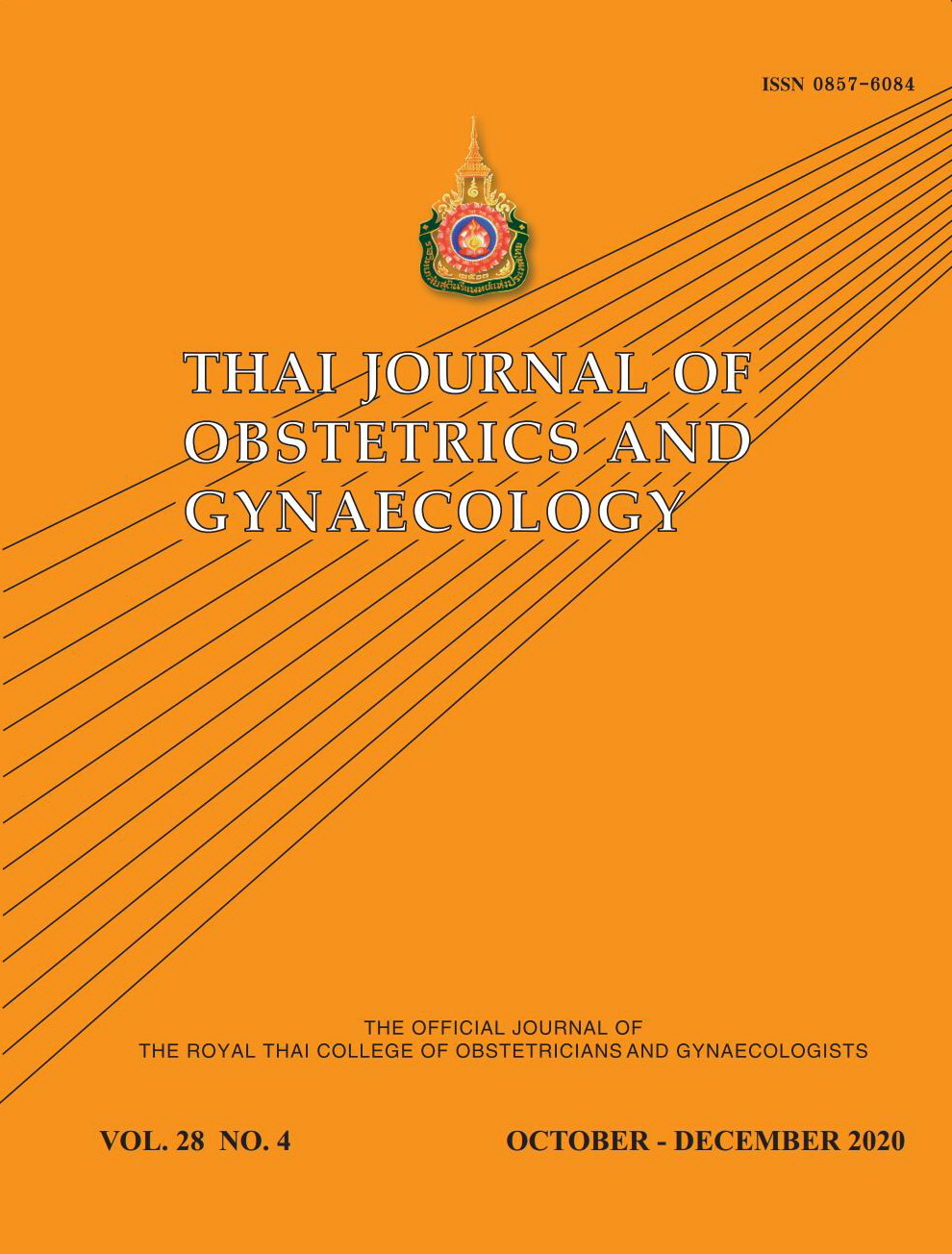Face Recognition of Newborn by Mother during Immediate Postpartum Period: An observational study
Main Article Content
Abstract
Objective: To determine the proportion of new mothers who could correctly recognize their newborns’ face during immediate postpartum period for the mother-newborn identification method.
Materials and Methods: A prospective observational study of healthy mothers and infants, who delivered vaginally without complications was conducted. Each mother was let to have a skin-to-skin contact with her newborn for 15 minutes. Then, she was tested if she could recognize her newborn’s face at two hours postpartum by picking the photo among other five different ones. The mother who could correctly identify the photo of her own baby was deemed as capable of recognizing hers.
Results: Among 88 participants, 54 (61.4%) could correctly identify the photos of their newborns while 34 (38.6%) could not. When the data between these two groups were compared with multivariate analysis, there was a statistical difference in maternal age, adequacy of skin-to-skin contact protocol, and level of maternal education. The older mothers had a higher rate of recognition than the younger ones. (adjusted odds ratio 1.115; 95% CI 1.013-1.227; P= 0.026). Also, those who completed 15 minutes of skin-to-skin contact protocol had a higher rate of recognition (adjusted odds ratio 4.209; 95% CI 1.570-11.285; P = 0.004). In addition, those who graduated from a secondary school or higher had a higher rate of recognition (adjusted odds ratio 5.518; 95% CI 1.490-20.433; P= 0.011).
Conclusion: The newborn’s face recognition by mother was imprecise accuracy. However, we suggest using this process for establishing mother-infant bonding rather than mother-newborn identification method.
Article Details
References
Pascalis O, Bachevalier J. Face recognition in primates: a cross-species study. Behav Processes 1998;43:87-96.
Mondloch CJ, Maurer D, Ahola S. Becoming a face expert. Psychol Sci 2006;17:930-4.
Eidelman A, Kaitz M, Rokem A. Recognition of newborn by mothers and nonparents: a comparative study. Pediatr Res 1987;11:180A.
Lamb ME. Early contact and maternal-infant bonding: One decade later. Pediatrics 1982;70:763-8.
Nissen E, Lilja G, Widström AM, Uvnӓs MK. Elevation of oxytocin levels early post partum in women. Acta Obstet Gynecol Scand 1995;74:530-3.
Savaskan E, Ehrhardt R, Schulz A, Walter M, Schächinger H. Post-learning intranasal oxytocin modulates human memory for facial identity. Psychoneuroendocrinology 2008;33:368-74.
Nasreddine ZS, Phillips NA, Bédirian V, Charbonneau S, Whitehead V, Collin I, et al. The Montreal Cognitive Assessment, MoCA: a brief screening tool for mild cognitive impairment. J Am Geriatr Soc 2005;53:695-9.
Natu V, O’Toole AJ. The neural processing of familiar and unfamiliar faces: a review and synopsis. Br J Psychol 2011;102:726-47.
Johnston RA, Edmonds AJ. Familiar and unfamiliar face recognition: A review. Memory 2009;17:577-96.
Haxby JV, Hoffman EA, Gobbini MI. Human neural systems for face recognition and social communication. Biol Psychiatry 2002;51:59-67.
Klatzky RL, Forrest FH. Recognizing familiar and unfamiliar faces. Mem Cognit 1984;12:60-70.
Germine LT, Duchaine B, Nakayama K. Where cognitive development and aging meet: Face learning ability peaks after age 30. Cognition 2011;118:201-10.
Phillips R. The Sacred Hour: Uninterrupted skin-to-skin contact immediately after birth. Newborn Infant Nursing Rev 2013;13:67-72.
Guerra CB, Katovich K, Bunge SA. Does higher education hone cognitive functioning and learning efficacy? Findings from a large and diverse sample. PLoS One 2017;12:e0182276.
Lemes RP, Bellon ORP, Silva L, Jain AK. Biometric recognition of newborns: Identification using palmprints. IJCB 2011;1:1-6.
Weingaertner D, Olga RPB, Luciano S, Mônica NLC. Newborn’s biometric identification: Can it be done?. VISAPP 2008 - 3rd International Conference on Computer Vision Theory and Applications 2008;1:200-5.
Shrikant T, Aruni S, Sanjay KS. Can face and soft-biometric traits assist in recognition of newborn?. 1st International Conference on Recent Advances in Information Technology 2012:74-9.


